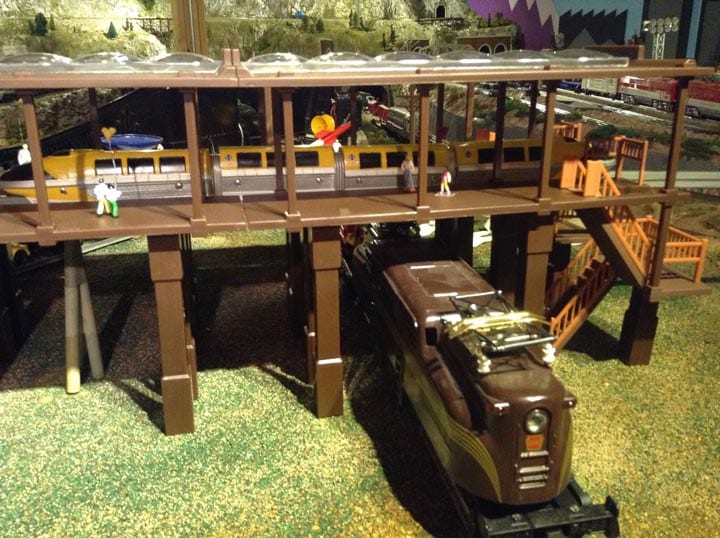Schuco and Their Classic Toy Train: The Sets
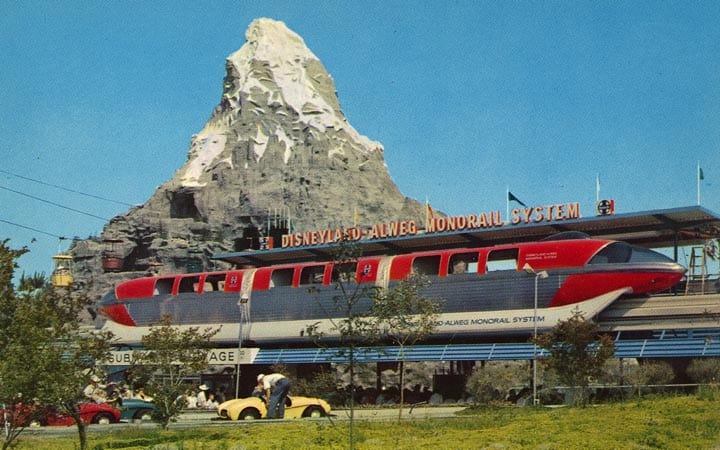
By Doug Burwell TCA #81-16885
I love Disneyland. I was born the year Disneyland opened, 1955. When I was one, my parents made the long road trek from Ohio to the new park located in Anaheim, California. Of course, I do not remember the visit at all, but the magic of Disneyland somehow injected itself into my blood.
As I grew older, I found a love for toy trains. Is it a coincidence that Walt Disney also loved trains? At first I had an American Flyer set, then later Lionel. But it was not until the 1990’s that I discovered the Schuco Disneyland monorail. I had seen want ads for these in the TCA periodicals, but had never seen one in person, and I had been to a lot of train shows! Then one day, at a Great Train Expo there sat a set on a seller’s table!
My teenage son was actually the one to buy that set. When we arrived home from the train show, we quickly set up the small square of track that came with the set. I dug out a DC transformer from an old HO train set, and we applied power to the red monorail sitting on the track. To our amazement, the over 35 year old train came to life! My first thoughts were: Where can I get more of these? How many were made? What colors did the monorails come in? Did Schuco offer any other different sets? Needless to say, I was hooked. I now had my connection to Disneyland and model trains.
It turned out that my son had just purchased the very first Disneyland monorail set Schuco made, the 6333/G set. It came out during the fall of 1961. The manual refers to the set as the “Gift” set, so I am assuming the “G” stood for “Gift” or “Geschenk” in German. Sets could be purchased not only at Disneyland, but at hobby shops throughout the world.
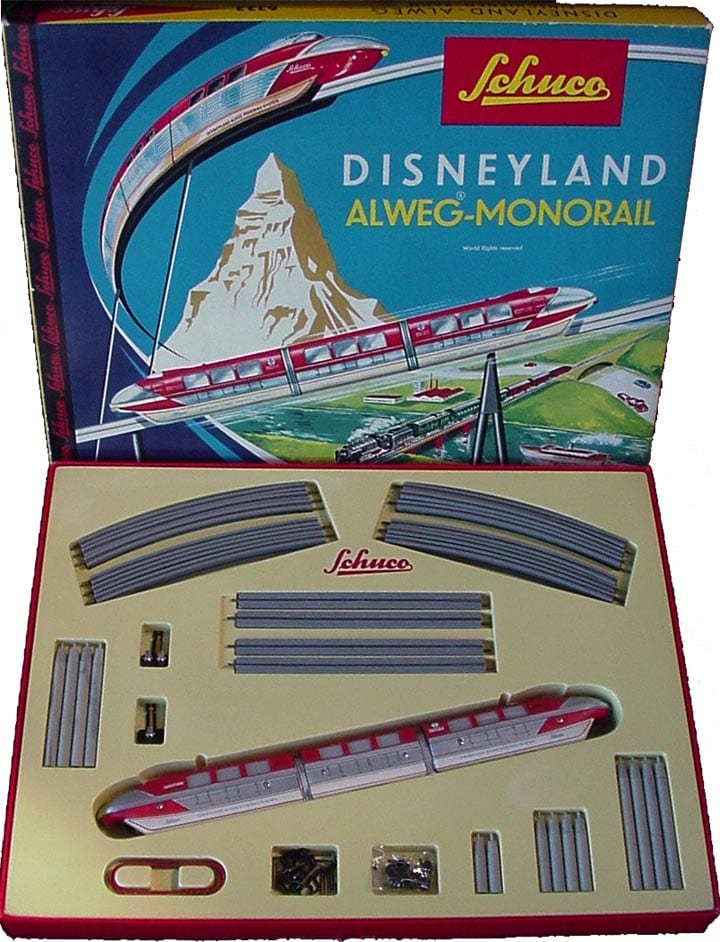
The set that my son purchased started my journey with the Schuco Disneyland monorail. It is also the first generation set introduced during the Fall of 1961.
This first set contained a red or blue monorail, the two original colors of the Disneyland-Alweg Mark I monorail that began operation in 1959. The set also included twelve curved tracks, four straight tracks, eight 80mm pylons, four 40mm pylons, two 25mm pylons and a various amount of small parts to assist with the operation of the train. Everything was stored in a yellow, thin plastic insert. The insert today is often found cracked or missing pieces.
The sixteen pieces of track made either a small square or long oval, depending how you positioned the four straight tracks. It was not a big layout, but it was a start, which was the idea of this set. The first tracks produced by Schuco were made of blackened steel and only had three holes underneath for pylon position. An operator only needs a pylon for every other track, so this set contained enough pylons, plus some more for further expansion!
The monorails in the first Gift Set were the lightest one’s ever made by Schuco and are usually the fastest running. To cut back on production costs, both the engine and rear cars are identical which meant that there was a driver’s bubble on both cars. The actual Disneyland monorail only had the bubble up front. The tin lithographed skirts on the front and rear cars of the Schuco model were also the same whereas the real Disneyland monorail had tail finned skirts with lights on the back.
Some people are surprised to see Santa Fe decals on the monorail. Walt Disney and Fred Gurley, the president of Santa Fe from 1947 to 1957, were good friends. Santa Fe had sponsored the Disneyland steam trains that encircled the park since opening day. When the monorails were added to Disneyland in 1959, the officials of the Atchison, Topeka, and Santa Fe Railway reminded Disney that they were to be the only sponsors of any rail system within the park. Thus, the Santa Fe logos were applied to the monorails until 1974 when Santa Fe did not renew their sponsorship with Disneyland. Santa Fe did allow the word “Alweg” to be included with the name of the monorail system and also the Alweg logo. The “Disneyland-Aweg Monorail System” lettering remained on the monorails until 1976.
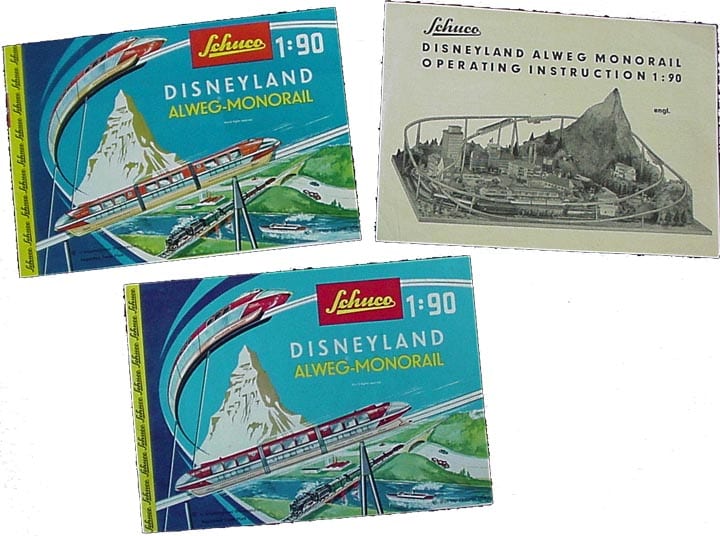
On top, the first generation set manual with the English translation booklet. On the bottom, the second generation set manual now showing tail fins on the monorail.
Schuco emphasized graphics, and the picture on the box of the Gift Set is beautiful. Comparing it to the original Disneyland monorail poster one may see some similarities. Is that the Matterhorn mountain on the background of the Schuco box lid? The 16 paged German manual that came with this set also bares the same graphic. For the American market, there was an English translation sheet that followed each page in the manual.
I have always read that the list price of this first Gift Set was $39.95, though I have not yet been able to find a price tag to verify it. Needless to say, this was a hefty price for 1961 toy, and it did not even come with a transformer as did none of the future Schuco Disneyland monorail sets. To put the cost of the Gift Set into perspective, in 1961 it only cost $3.50 to enter Disneyland and $4.75 for both admission AND ten adventure tickets! $39.95 for a family of four may have been all the funds they required for that day for admission, attraction tickets, and food!
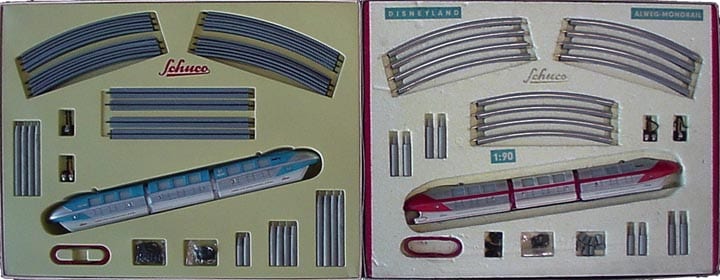
The first generation set (left) and second generation set (right). The silver monorail is the rare version that has red painted bolsters.
In the 1962 Schuco catalog, Schuco commented that their Disneyland monorail “had obtained brilliant sales results.” However, the 6333/G set would now have several changes. First, the plastic insert was replaced with a stronger Styrofoam. The insert now only held twelve curved tracks, no straights. The layout was now cut back to a basic 27″ circle. The rails of the tracks were made of brass, not steel. There were only six 40mm pylons and two 25mm pylons instead of the fourteen various pylons offered before. All this to cut back the price to $29.95.
There were some improvements introduced. A design change on the rear units now included Cadillac-like tail finned skirts similar to those that were on the original Mark I at Disneyland. The monorails had two weight plates added to the engine. One of those plates activated a special accessory, the 6333/26 automatic controller which could be purchased separately. The controller would trigger another new accessory, the 6333/20 electric switches.
Schuco also added a third color to the monorail lineup: silver. Disneyland did not run a silver monorail, so why Schuco chose this color can be asked. Possible answers are that an original monorail drawing by Disney Imagineer, Bob Gurr, was possibly silver; or that Schuco had several other silver painted automobiles in their production line so it was simple to add the color silver to the monorail line.
To distinguish between the two Gift Sets, collectors often refer to the first set as the first generation set and the revised set as second generation. Logically, one would think that there would be very few first generation sets available today since it was only offered for around a year; however, Schuco must have manufactured several in anticipation of high sales. One will find a mix of styles of tracks and monorails placed in the plastic yellow inserts of the first generation sets. Schuco was simply a toy company making do with what they had in stock at the time.
The colorful graphic on the box of the second generation set remained the same as the first generation set, though later the graphic would disappear from the boxes as Schuco cut back on costs. The new 1962 manual cover appeared to be the same as the old sixteen paged manual, but if one looks closely, the red monorail zooming over the pastoral landscape now displayed tail fins. Manuals were offered in German, English, French, and possibly Italian. It was also expanded to 24 pages and included a picture of the revised Gift Set along with another set offered, the 6333/S set!
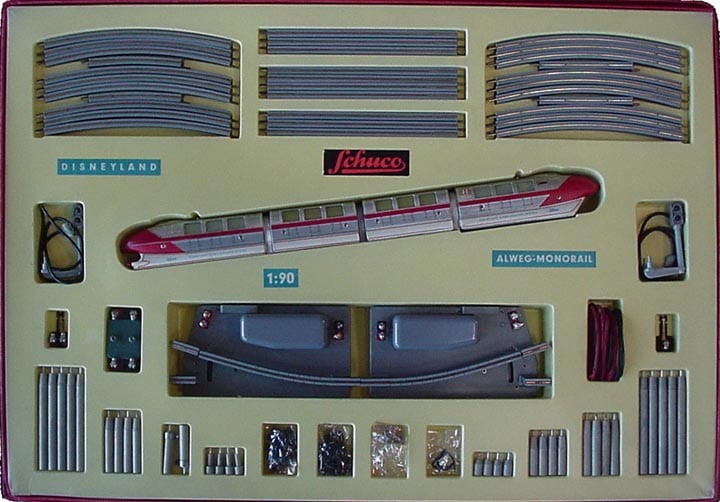
The 6333/S set with a paper Schuco logo instead of the usual red painted one.
The 6333/S Set was the largest Disneyland monorail set manufactured by Schuco. I believe the “S” stood for “Super.” There were over 200 parts in this set, including a four unit monorail, all placed in a thin plastic insert. The four car monorail Schuco offered in the S Set matched some of the 1961 changes Disneyland made to the Mark I monorails. They added a middle car and doubled the driver’s bubble size in the front car. The Mark I now officially became the Mark II monorail. Disneyland also added a yellow monorail or “monorail gold,” but Schuco never offered that color nor did they widen the driver’s bubble. Today, operators have created their own versions of “monorail gold” using original beat up Schuco monorail shells.
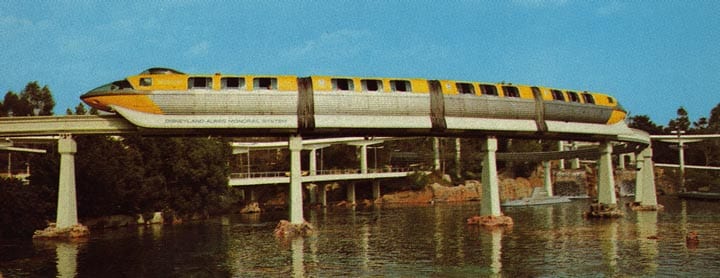
Add a middle car, widen the driver’s bubble, and splash on some yellow paint and you have “Monorail Gold” introduced at Disneyland in 1961.
The 6333/S set included a pair of switches and enough track and pylons to make an over and under figure eight. With the switches, a side track could be added. Block signals could be attached to the switches. This set contained great play value, but came at a price. I have read that the list price was $89.95, but have had collectors tell me that they remember paying as much as $125. It is doubtful that many families walked out of Disneyland with a $100 monorail set, and probably those few were surprised to discover that they had to purchase a transformer in addition to the high priced set.
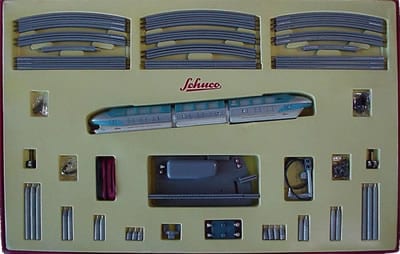
The American Set sold from Christmas of 1962 to Christmas of 1967
The next set offered by Schuco was geared specifically for the American market and today is referred to as the “H” set or the “American” set. Schuco never numbered the set, nor did they list it in their own catalog. The set was sold in American hobby shops and advertised in American toy catalogs. Examples of publications it appeared in were the 1962 to 1967 F.A.O. Schwarz Christmas catalogs. For the first two years the set listed at $49.95 and for the remaining four years at $39.95. A transformer was not included, but at least one was listed directly below the set for around $12. Schuco made the 6333/150 transformer for the monorails, but there was no specific mention of what transformer was being offered in the F.A.O. catalog. In my experience, when I purchase an American Set from a collector, I often receive a 110 volt version of the Schuco #150 transformer with it, so more than likely the Schuco transformer was probably the one listed. The 110 version of the #150 transformer is very difficult to find.
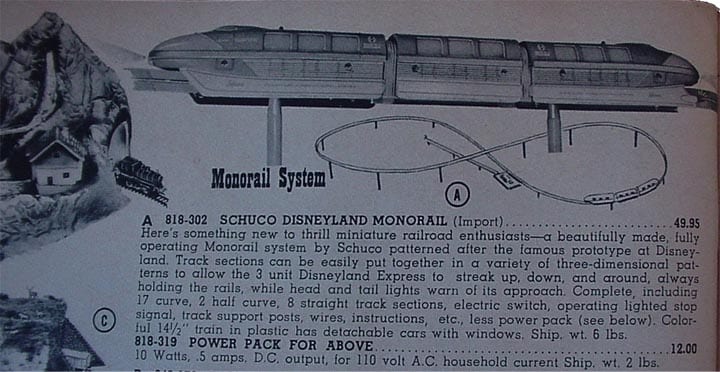
The H set or American Set listed in the 1962 F.A.O. Schwarz Christmas catalog.
The American set was very similar to the 6333/S set except that it only contained a three unit monorail, one switch, and one end of the track bumper. All pieces were placed in a yellow plastic insert. There were fewer tracks and pylons than the S set, but an operator could still build an over and under figure eight. The set also often contained the rare and sought after English version of the Schuco 24 paged manual.
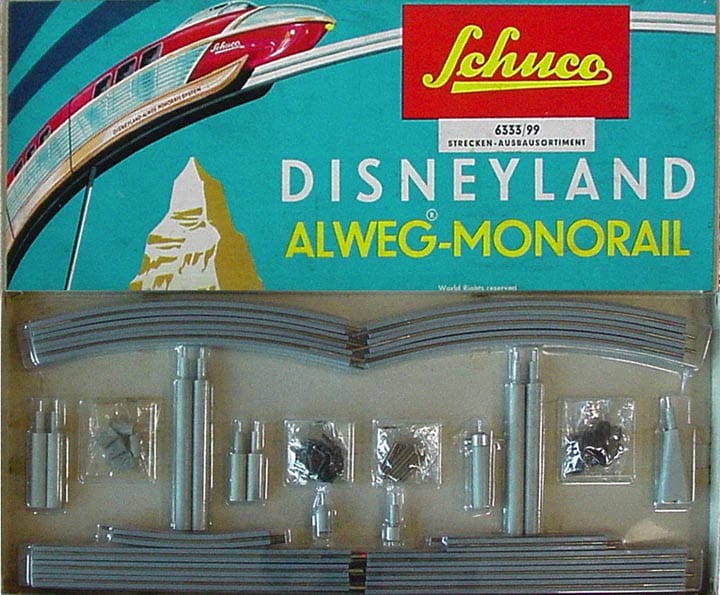
The extremely hard to find 6333/99 Accessory Set.
A final Schuco Disneyland monorail set to note is the 6333/99 Accessory Set. This set first appeared in the 1963 Schuco catalog and did not contain a monorail. The Accessory Set consisted of six straight and curved tracks, several heights of pylons, and enough pieces to convert the simple circle of track a person received with a Gift Set into an over and under figure eight. Today, the Accessory Set is extremely hard to find complete with box and clear plastic insert in any shape, but it is a special treat to find one in very good or better condition.
It is enjoyable to collect and study the variations of each Schuco Disneyland monorail set. In the second generation Gift Sets, the Styrofoam changed from yellow to white. Stripes and logos of different colors were added. In the 6333/S sets and American sets there were changes made to the thickness of the yellow plastic insert. Also some minor graphic changes occurred, especially in the 6333/S sets. Gift Sets are easier to find, than 6333/S Sets. Here in North America, it is surprising that the American Sets are more difficult to find than either the Gift Sets or the S Sets, but one must consider that they were probably not offered in Europe during the 60’s; therefore, fewer were made.
If you are lucky enough to find a boxed set and discover some parts missing, more than likely you will be able to find them and complete your set. I do not think there is a better reward in toy train collecting than making a 50 year old classic train set complete, except for maybe……………well, that’s the next installment to this series!
